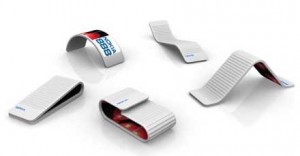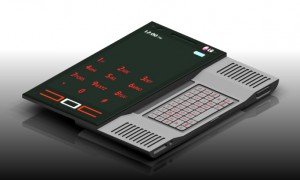There are cell phones for everyone’s tastes (or almost). But often, they follow a simple fad. Now, the majority of mobile phones in mid-range and top of the range look like the iPhone, with a large touch screen, an effective format for a multimedia use. On the other hand everyone does not necessarily want a clone of the iPhone in their pocket. Some look for something less conventional but are designers lacking creativity? Not at all as we will see below.
What is form factor?
The look of a mobile is particularly important because it is a guiding factor in the purchasing act. That’s why, manufacturers are always very careful with design. However, the design of some models is their main differentiating factor. Indeed, they are not equipped with outstanding features but… they are so beautiful! These swaggering mobiles, although basic from a technological point of view, can be very expensive. The LG Prada or the Samsung Giorgio Armani exemplify well this category.
We have also different “form factors” where mobile phones are categorized:
![]() The Candy Bar mobile
The Candy Bar mobile
This kind of mobile looks like a candy bar. This is the most classical format. It is often looked as a low-end mobile but it is appreciated by its robustness. However, the available space to host the keyboard and the screen is limited. That’s why these elements are compact. Take away the keyboard and put a tactile screen and you have the candybar fondle slab that we know so well
![]() The clamshell phone
The clamshell phone
The clamshell was imported from Asia. It’s offering the advantage of a large screen and a large keyboard in a compact shell. These phones usually allow access to many features without having to open it. The Japanese market has hundreds of models available.
![]() The “slider” mobile
The “slider” mobile
Invented by Sagem, popularized by Samsung, this format has experienced tremendous success in recent years. It is practical and aesthetic both vertically and horizontally, offering a real keyboard for users who dislike tactile input. Note that the ease of use depends on the quality of the sliding mechanism.
The rotary phone
Motorola launched the first rotary keyboard mobile, the V70. Main advantage: originality!
Wacky phones!
The Nokia N95, for example, opens like a clamshell and, in addition, the screen swivels! By the same manufacturer, the E70, usually reserved for professionals, is offering a full keyboard when it is opened επίσημη αίτηση… We can see that the design is not only a matter of “beauty”. It’s also a matter of Lifestyle. Indeed, I found an article about the design research at Nokia:
“Nokia’s strategy for design focuses on anthropology, the study of consumer lifestyles and understanding of the integration of mobile phones in daily lives. That is why Nokia does not focus on just one type of design or a specific market segment. » Younghee Jung (Senior Design Manager at Nokia) explained: « Our designers are constantly studying the different needs and lifestyles of consumers by conducting research and anthropological studies around the world. Based on results of these researches, we develop technology to create designs, textures, features and services that consumers like and want to use. »” (Source: http://www.lemobilium.com/index.php?page=destination-design-event)
Here is an overview of what the future plans for mobile technology with some interesting new trends: projectors, flexible screens, liquid batteries, and customizations…
Nokia Morph:
This concept is already 2 years old but do not look for it in shops, it is not ready to be produced. This is a concept phone which could take many forms as needed. For Nokia, it would be possible to produce it with future developments in nanotechnology.
Nokia Communicator 888:
This is a realistic and fantastic mobile phone. This Nokia is equipped with a flexible touch screen and a liquid battery
It is designed by Tamer Nakisci and won the Nokia Design competition in 2011.
LG Burst:
This is a smartphone which is able to project images on flat surfaces.

LG Glide:
This is a concept phone with a projector and a LED 3D screen.
The LG stereo folding:
LG releases often innovative prototypes: This one is a folding phone Stereo headset of the LG brand and it is not impossible that it will appear one day in stores.
But when we see these new cell phones, we have to ask ourselves how and why is design important?



5 réponses à “The future of cell phone design”
Interesting article Sandy.
The link between engineering and form factor can be seen here.
http://youtu.be/z7r8sKzt7HM
Here you have a very interesting video that summarizes what Sandy has said in her article and that shows the pros and cons of each cell phone’s form: the Clamshell phone, the Candy Bar phone and the Slider phone:
http://www.youtube.com/watch?v=inB3BDvVXVI
Enjoy it!
I like the new concepts of mobile cell phones but few of them are quite strange and funny e.g. Nokia Coca-cola Phone. Very similar concept with Nokia Communicator 888 is Samsung Galaxy Skin what is also very interesting concept and computers concepts with solar panels or recyclable laptop. There is very interesting article about it http://www.ecofriend.com/entry/15-eco-friendly-concept-computers-for-green-computing-in-the-future/. I think that in the similar way will be created mobile phones like concepts of PCs but we can’t guess what market will be preferred.
In fact, it was really good for me to read this atricle, because I have never thought about how mobile phones might look like in the future.
However these concepts of mobile phones from you article don’t convince me that much. It’s is hard to believe right now that the smartphones we use have millions of application and in 20-30 years we will get back to ‘phone and text’ mobile phones. So after reading your article, I decided to google it because I am rather interested how the future smartphones will look like. So I have found a video which includes few future smartphones designs:
http://www.youtube.com/watch?v=DJdD6NHW0xI
But if I have to choose one concept from your article, I will probably choose the LG Burst. I hope to see it in shops one day.
Klaudia is right, for me it would be useless to have a cool smartphone in my wrist if I can’t access Facebook or Twitter. I’m sure a lot of those concepts will never see the light of day for this reason. One thing is to think outside of the box and other it’s to go back to 1997.
I don’t think smartphones are like clothes that have a life cycle.